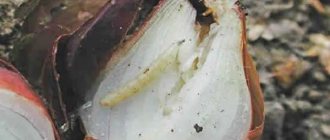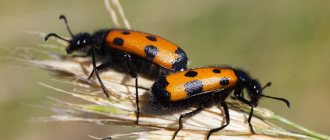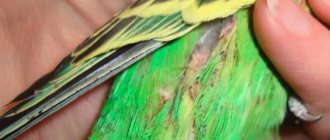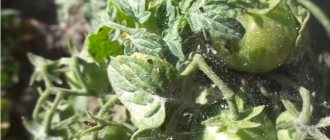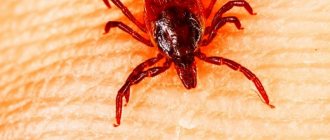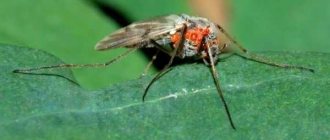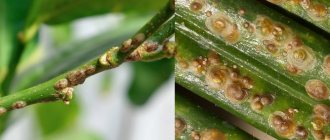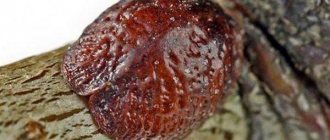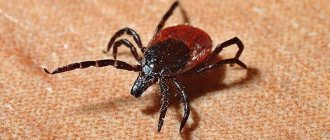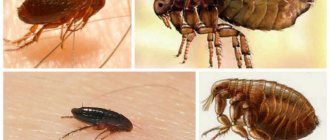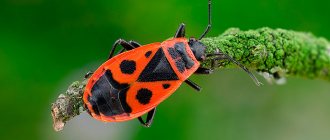Plants » Flowers
0
1567
Article rating
Kira Stoletova
Growing orchids at home brings a lot of positive emotions to its owner. This is a beautiful and sophisticated plant, pleasing the eye with its color palette and subtle, barely noticeable aroma. Everything is fine until pests appear. Mites on orchids can destroy the plant.
How to get rid of spider and orchid mites on orchids
Step-by-step instructions on how to get rid of various pests
Arachnoid
After detecting a spider mite on an orchid, you can get rid of it using several methods:
- Biological. It is enough to have several walls of predatory beetles that will destroy adult ticks.
- Chemical. Insecticidal preparations need to be alternated, as parasites develop immunity to the products used. In addition, a one-time treatment will not be enough; it will have to be carried out systematically. The following drugs are effective: Metaldehyde, Thiophos, Actellik.
- Folk. To combat spider mites, you can use a decoction of cyclamen roots. Pour water over the tubers, boil for 30 minutes, leave for 24 hours, and use the resulting filtered liquid to spray the orchid. Carry out treatment every 5 days 3-4 times. Simply wiping the orchid leaves with a cloth soaked in alcohol will help get rid of spider mites.
We invite you to watch a video on how to get rid of spider mites:
Bulbous
As soon as this pest is discovered, it is necessary to immediately change the soil in the pot. You can get rid of bulb mite in the following ways:
- Folk. Using folk remedies is effective only at the early stage of the infection, when the mites have not spread much. A solution of laundry soap is suitable (20 g of raw materials per 1 liter of water). You can use it to wipe orchids or immerse the flower completely in the solution. You can try spraying the plant with a weak solution of potassium permanganate.
- Chemical. Flower growers use general-spectrum insecticides.
But you can also use highly specialized drugs that will only fight ticks - these are acaricides. To prepare the solution, you need to use the instructions indicated on the package. The concentration can be made weaker, but not stronger, otherwise the opposite effect is possible. It is necessary to soak the flower in the prepared solution, and send the roots back into the soil only when they are completely dry.
Root
This parasite is the most difficult and tenacious to remove. It has a high ability to recover and reproduce. If a root mite is noticeable on the orchid, then all affected parts of the flower must be urgently removed, and the cut areas must be treated with activated carbon powder. Affected plants must be isolated from other healthy ones. Throw away the soil immediately and disinfect the pot.
Folk remedies suggest using a nettle decoction, which will not only eliminate pests, but also increase the flower’s immunity.
To prepare the solution, you need to: take 700 g of fresh herb, pour 5 liters of boiling water and leave for 30 minutes in a dark place.
How to treat a plant? This is done within 5 minutes, immersing the entire orchid in the broth. Of the chemical preparations, ascaricides remain effective. You can also use the insectoacaricidal agent Acaritox against pests. Use it strictly according to the instructions, and the frequency of treatment is every 5-7 days.
Biological products are also effective against root mites:
- Verticillin;
- Summer resident;
- Nematophagin.
Flat beetle
To quickly and effectively get rid of the parasite, it is better to immediately use chemicals - acaricides. Since mites are not insects, it is useless to use insecticides.
Most often used:
- Actofik;
- Fitoverm;
- Vermitek.
You can use folk remedies that were given earlier, but they are only effective at the early stage of infection.
Armored
This parasite lives underground, so you need to get rid of it as quickly as possible. To do this, the first step is to remove the flower from the soil and soak the root system in water for half an hour.
3-5 minutes after diving, you will see the parasites begin to emerge. After half an hour, remove the root system from the water and lay it down to dry. Carry out activities 2-3 times to get maximum results. When the roots are dry, you can transplant the plant into new soil. If you use chemical control methods, then acaricidal drugs are effective, including:
- Karbofos;
- Sumiton;
- Aktellik
In the store you can buy a predatory mite - Hypoasmis myles. One package will be enough to completely get rid of parasites.
From the video you can learn how to get rid of armored mites:
Differences between armored and spider mites
There are many types of oribatid mites; scientists count more than 6,000 species of these arthropods. Almost any of them can be seen on orchids, but the most common are the small, black, shiny, round mites. They mainly choose bark-based substrates as their habitat. The armored mite, unlike the arachnid arthropod, does not cause much harm to orchids; it is, as it were, its good neighbor. This species causes real harm when the colony reaches catastrophic numbers, which is extremely rare. The differences between these two types of ticks are summarized in the table.
| Arachnoid | Armored |
| Color: whitish, dirty gray, sand, light brown, yellowish with brown spots. The average size of adult individuals reaches .01-0.3 mm. | The color of the body is black or dark brown. Its dimensions range from 0.7 to 0.9 mm. Brown or reddish-tinged eggs can be seen with the naked eye. |
| Slow arthropods, capable of crawling 5 mm in 1-2 minutes. Most often they sit motionless. | Quite nimble pliers. In one second they are able to overcome 5-7 mm. |
| Despite the fact that spider mites are not afraid of light, they settle on the back side of sheets and are easily retained there. | They do not like light and when it appears they run away to secluded places. |
| They settle throughout the plant, laying their eggs on green leaves, shoots, and stems. | They also prefer to crawl all over the plant. For laying eggs, they choose fallen leaves, rotten roots, twigs located in the ground, i.e., decomposing organic matter. |
| For the development of spider mites, soil and air moisture does not matter. | The development of armored arthropods occurs only in damp soil and a humid environment. |
Disease prevention
To prevent mites from appearing on orchids, the following preventive measures must be observed:
- Periodically dry the soil in which the flower grows.
- Spray the flower in a timely manner and ensure that drops of liquid do not stagnate in the axils of the leaves. Otherwise, the orchid will rot.
- Maintain the optimal watering regime.
- Ticks appear in rooms with dry air. You can increase the humidity by placing a container of water at room temperature near the orchid for 2 days. The water will evaporate and the air will become humidified.
After infection with small insects, white or other bugs, mealybugs, scale insects or midges, the orchid begins to slowly die. Regular inspection of all parts, careful care, and regular preventive treatments will help to protect the plant.
Caring for an orchid is very difficult, especially when it comes to pest control. The difficulty is that the flower is attacked by small parasites such as mites. It is not always possible to see them immediately and eliminate them in a timely manner, so you have to resort to more aggressive methods of control when the accumulation of pests is already massive.
If you find an error, please select a piece of text and press Ctrl+Enter.
Classification
The order belongs to the clade Sarcoptiformes
superorder
Acariformes
.
It unites about 200 families, more than 1200 genera and about 6600 species, including the model species Nothrus palustris
(Crotonioidea, Nothridae)[11].
According to other views, oribatids are considered as a suborder and, together with Astigmata,
include 249 families, 2399 genera and about 16 thousand species [12]. For the USA and Canada, 1177 species, 329 genera, 108 families and 44 superfamilies are indicated[13]
- Clade Sarcoptiformes
Order
Oribatida
(Cryptostigmata) by Subías (2009)[14] Suborder
Brachypylina
Infraorder
Poronoticae
Superfamilies:
Achipterioidea, Ceratozetoidea (
Ghilarovizetes
), Galumnoidea, Licneremaeoidea, Limnozetoidea, Oribatelloidea, Oripodoidea, Phenopelopoidea , Unduloribatoidea, Zetomotrichoidea
- Superfamily Amerobelboidea
,
Eremaeus
), Eremelloidea, Gustavioidea, Gymnodamaeoidea, Hermannielloidea, Hydrozetoidea, Microzetoidea, Neoliodoidea, Niphocepheoidea, Oppioidea, Otocepheoidea, Plateremaeoidea, Poly pterozetoidea, Tectocepheoidea, Trizetoidea, Zetorchestoidea
- Superfamilies: Atopochthonioidea, Brachychthonioidea, Cosmochthonioidea, Hypochthonioidea, Protoplophoroidea
(
Desmonomata
)
- Superfamilies: Crotonioidea (Thrypochthoniidae, Malaconothridae, Nothridae, Camisiidae, Crotoniidae), Hermannioidea (Hermanniidae), Nanhermannioidea (Nanhermanniidae)
- Infraorder Dichosomata
Superfamilies:
Epilohmannioidea, Eulohmannioidea, Lohmannioidea, Nehypochthonioidea, Perlohmannioidea
- Superfamily Euphthiracaroidea
(
Microtritia stria
)
(or in
Hypochthonioidea
according to Norton & Behan-Pelletier (2009: 440))[15]
- Superfamily Acaronychoidea
)
- Superfamily Parhypochthonioidea
Why protect bees?
Honeybees (Apis mellifera) are of great importance to humanity and the environment. For many years, bees have been bred to produce honey, wax, propolis, bee venom and other bee products. A. mellifera is one of the most important pollinators in all natural ecosystems studied, due to its wide distribution and generalized foraging behavior [1]. Bees pollinate plants, parts of which (for example, nuts, berries, seeds, fruits) are eaten by many animals [2]. Pollination by bees leads to an increase in the quantity and quality of seeds and fruits, and can also serve to protect crops from pests [3]. Bee-pollinated strawberries have been shown to produce more commercially valuable fruits with a longer shelf life compared to self-pollinated and wind-pollinated strawberries [4]. Cross-pollination by bees promotes genetic variability, adaptability to changing environmental conditions and biodiversity. These insects are model organisms in scientific research in developmental biology, sociobiology, memory, learning, and even in gut microbiota research [5].
Unfortunately, the life of bees is not as sweet as the honey they produce. A phenomenon called colony collapse disorder is observed around the world. There are many factors that negatively affect the abundance of A. mellifera. Of these, habitat fragmentation and destruction, pesticide use, pathogens and parasites have the greatest impact.
Habitat fragmentation and destruction are among the main factors contributing to the decline in bee numbers. The development of agriculture, the construction of roads and cities lead to a reduction in flower meadows and nesting sites for wild bees. Habitat fragmentation can isolate species, impeding gene flow between populations and reducing genetic diversity. As a result, the vulnerability of species to diseases and parasites increases [6].
The use of insecticides—pesticides used to control insect pests—in agriculture can also pose a great danger to bees. Direct contact of a bee with insecticides causes the bee to die and not return to the hive. In this case, the bee does not infect the rest of the bee family and the colony survives. But in another case, the bee may bring the insecticide along with pollen or nectar to the hive, and then the entire colony may die [7]. A class of insecticides called neonicotinoids is highly toxic to bees.
In addition, bees suffer from a wide range of pathogenic organisms (viruses, fungi, bacteria, etc.) and parasites. One of the most famous parasites of the honey bee is the Varroa destructor mite [8]. This article is dedicated to him.
Notes
- M. S. Gilyarov, F. N. Pravdin Animal Life Volume 3
. — Publishing house “Prosveshcheniye”, 1984. 2nd revised edition. Page 74 - Proctor H. (1998). [tolweb.org/Acariformes/2563/1998.08.09 Acariformes. The "mite-like" mites.] in The Tree of Life Web Project. (English) (Retrieved October 23, 2010)
- Anderson JM, 1978. Inter- and intrahabitat relationships between woodland Cryptostigmata species diversity and the diversity of soil and litter microhabitats.
Oecologia, 32: 341–348. - Wallwork JA, 1983. Oribatids in forest ecosystems.
Annual Review of Entomology, 28: 109–130. - Travé J., 1963. Écologie et biologie des Oribates (Acariens) saxicoles et arboricoles.
Vie et Milieu, suppl. 14:1-267. - Ito M., 1986. An ecological survey on arboreal oribatid mites (Acari: Oribatida) in a subalpine coniferous forest of Shiga-Kogen, Central Japan.
Edaphologia, 35: 19-26. - Winchester NN, Behan-Pelletier VM, Ring RA, 1999. Arboreal specificity, diversity and abundance of canopy-dwelling oribatid mites (Acari: Oribatida).
Pedobiologia, 43: 391–400. - Walter DE, Behan-Pelletier V., 1999. Mites in forest canopies: filling the size distribution shortfall?
Annual Review of Entomology, 44: 1-19. - Behan-Pelletier V.M., Eamer B., Clayton M., 2001. Mycobatidae (Acari: Oribatida) of Pacific Northwest canopy habitats.
The Canadian Entomologist, 133: 755–775. - Domes, Katja;
Norton, Roy A.; Maraun, Mark & Scheu, Stefan [www.pnas.org/content/104/17/7139 Reevolution of sexuality breaks Dollo's law] (English) // PNAS. - 2007. - Vol. 104, fasc. 17. - P. 7139—7144. - Walter, David Evans, ed. [insects.tamu.edu/research/collection/hallan/Acari/Family/Oribatida1.htm Oribatida Species Listing]. Biology Catalog. Texas A&M University. Retrieved on August 26, 2010.
- Schatz, Heinrich; Valerie M. Behan-Pelletier; Barry M. OConnor and Roy A. Norton. (2011). Suborder Oribatida van der Hammen, 1968. In: Zhang, Z.-Q. (ed.) 2011: Animal biodiversity: an outline of higher-level classification and survey of taxonomic richness. Zootaxa, 3148: 141–148. ISBN 978-1-86977-849-1 (paperback) ISBN 978-1-86977-850-7 (online edition)
- Valin G. Marshall, R. Marcel Reevrs and Roy A. Norton. (1987). [journals.cambridge.org/action/displayAbstract?fromPage=online&aid=8560881 Catalog of the Oribatida (Acari) of continental United States and Canada.] Memoirs of the Entomological Society of Canada / Volume 119 / Supplement S139 / January 1987, pp 1 -418.
- [www.ucm.es/info/zoo/Artropodos/Catalogo.pdf Subías, LS: LISTADO SISTEMÁTICO, SINONÍMICO Y BIOGEOGRÁFICO DE LOS ÁCAROS ORIBÁTIDOS (ACARIFORMES: ORIBATIDA) DEL MUNDO (Excepto fósiles)] Version: April 2009
- Norton, R.A.; Behan-Pelletier, V.M. 2009: Chapter fifteen. Suborder Oribatida. pp. 430—564 in: Krantz, GW; Walter, DE (eds) A manual of acarology. Third edition. Texas Tech University Press, Lubbock Texas.
